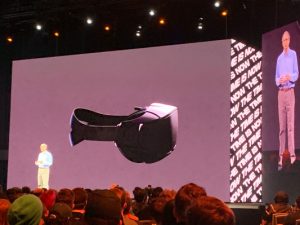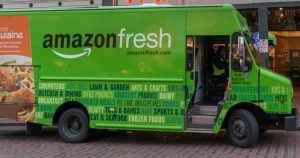More than a decade into the modern age of electric driving, the auto industry has brought batteries to just about every kind of car. Depending on your taste and means, you can take home a city runabout, a startling sports car, a luxury SUV, a pickup truck, and more without leaving any emissions in your wake. You can even do a bit of trail scrabbling in an elevated, all-wheel drive “soft-roader” like the Jaguar I-Pace. But if you’re serious about off-roading—if you want to summit boulders and smash through rivers—you’ve still got to rely on a ride powered by internal combustion.
Robert Bollinger is working to fix that. His eponymous company last week fleshed out its plan to conquer the wilds on battery power, with an all-electric four-door SUV and four-door pickup truck. Dubbed the B1 and B2 respectively, the ultra-rugged duo follow Bollinger’s 2017 reveal of a two-door SUV concept. “I knew I wanted to develop an electric vehicle, but I didn’t want it to be a little roadster,” says Bollinger, a serial entrepreneur who has funded the effort with profits from the sale of a hair product manufacturer where he was CEO. “I wanted a tool. Something I can use on my farm—a truck that can hold plywood and two-by-fours and have the kind of off-road capabilities that our most avid supporters want as well.”
Want the latest electric driving news in your inbox? Sign up here!
Bollinger Motors, which started in upstate New York in 2015 and recently moved to Detroit, is just one of many electric-focused industry newcomers looking to cut off a piece of a pie long dominated by just a few major automakers. Rivian just landed an order for 100,000 electric vans from Amazon. Dyson has filed some rather interesting patents. Virya Mobility 5.0 is making electric rickshaws in India. But with their straight edges and minimalist surfacing, Bollinger’s new bash brothers look less like the future than the military-grade Hummers of old.
Bollinger’s vehicles comes with a two-speed transmission, a tech that’s slowly catching on in the EV world.
Photograph: Eric AdamsWhich is fine, because each has the features trail-bashers care most about. Their massive off-road tires offer 10 inches of wheel travel. Their ground clearance of 15 inches trumps the Jeep Wrangler’s 11. They can splash through water 3 feet deep. Their dual electric motors produce 614 horsepower and 668 pound-feet of rock-conquering torque. They’ll carry a 5,000-pound payload. You can remove their doors and windows for a better view of interiors light on creature comforts, but made to be durable and easily hosed down after the action’s over. The trucks will carry 120 kWh batteries, bigger than any pack on the market today. That will enable more than 200 miles of range per charge, the company estimates, which isn’t bad considered the power and not-exactly-aerodynamic profile of the vehicles.
The trucks also come with some clever engineering. To deliver that extra ground clearance, Bollinger used what are called portal axles. These use separate gearboxes to raise the axles out of the undercarriage, freeing up space between the vehicle and the dirt. The company also developed its own two-speed transmission for each motor. Multispeed transmissions are slowly catching on in a mostly single-speed EV world. Porsche just introduced one in the Taycan, and transmission maker ZF has one in the pipeline. They offer advantages in delivering higher top speeds and greater acceleration for road cars, along with improved efficiency.
They’re good in the wild too, it turns out. “As you get to an off-roading scenario where you have to climb steep grades while hauling a heavy payload, you really can’t do that all in one gear,” says Bollinger drivetrain engineer CJ Winegar. The vehicles need to operate on steep grades and with heavy payloads, but deliver some reasonable level of efficiency on the highway.
Elsewhere, Bollinger is keeping things simple and, hopefully, on the cheap side. The company will source batteries and motors from external suppliers. It will outsource vehicle production too, and is now evaluating four manufacturers interested in the job. It’s a relatively small contract: Bollinger expects to remain low-volume indefinitely, starting with 1,000 units in 2021. Hiring established manufacturers takes the need for a complex and expensive factory off the table, allowing the company to focus on product design and engineering, Bollinger says.
In that respect, the EV maker is already well ahead of the learning curve. In addition to the engineering innovations in the transmission and portal axles, Bollinger’s introducing some clever design tricks to the off-road world. Both vehicles feature full pass-through storage from front to rear—a perk of the engine-free configuration—along with a sleek interior dome light that also stretches from front to rear, and retro-futuristic design touches such as an old-school stalk-mounted gearshift, knurled knobs for the dashboard controls, and exterior panels that are riveted in place (à la Airstream).
The auto industry might be more open today than in past decades, but launching a new company remains a challenge. Bollinger is arranging hefty financing and courting potential customers in both commercial and military markets. And where others offer bold timelines, he remains cautious about when his vehicles will hit the trail—likely in the 2021 model year. But he’s confident that no other carmaker will offer vehicles like his. Though Rivian is also developing an off-roadable SUV and pickup truck, those vehicles lack the same clearance, suspension travel, or unsprung weight. That’s because they use wheel-mounted electric hub motors—a no-go in the off-road world. That community, along with utility-obsessed customers looking to haul major loads of plywood and other stuff, will for the time being have but one place to turn off the road: Bollinger.
More Great WIRED Stories
- Netflix, save yourself and give me something random to watch
- Tesla’s “Smart Summon” will fetch your car—sometimes
- How amateur video is helping us understand deadly tsunamis
- Google’s “quantum supremacy” isn’t the end of encryption
- An end to pornography, sophistry, and panty raids
- 👁 If computers are so smart, how come they can’t read? Plus, check out the latest news on artificial intelligence
- 📱 Torn between the latest phones? Never fear—check out our iPhone buying guide and favorite Android phones



